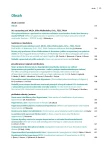The effect of adding phytosterol to hypolipidemic therapy with statins on the size of lipoprotein particles in patients with very high cardiovascular risk
Authors:
Andrej Dukát 1; Ján Gajdošík 2; Peter Sabaka 1; David Baláž 1; Lucia Mistríková 3; Stanislav Oravec 1; Peter Gavorník 1; Ľudovít Gašpar 1
Authors‘ workplace:
II. interná klinika LF UK a UN Bratislava, Slovenská republika, prednosta doc. MUDr. Ľudovít Gašpar, CSc.
1; Neštátna ambulancia pre dospelých v Nových Zámkoch, Slovenská republika, vedúci pracovník prof. MUDr. Ján Gajdošík, CSc.
2; Východoslovenský ústav srdcových a cievnych chorôb, a. s., Košice, Slovenská republika, predseda predstavenstva
MUDr. František Sabol, PhD.
3
Published in:
Vnitř Lék 2015; 61(5): 398-400
Category:
Original Contributions
Overview
Despite significant improvement in the diagnosis and therapy of cardiovascular diseases their global risk and proportion of their clinical forms remains very high. Still the large part of the patients cannot reach the estimated target lipid levels despite statin therapy. Low adherence to preventive programmes with physical training and diet leads to progression of the pathological process of atherothrombosis. One possible therapeutic approach could be the combined hypolipidemic treatment. In this context we followed-up the size of lipoprotein particles among very high risk patients on statin monotherapy, where phytosterole was added. Lipoprotein profile among very high risk patients during combined therapy lead to improvement and therefore may contribute to lowering of their residual risk.
Key words:
cardiovascular pharmacotherapy – phytosterols – hypolipidemics – lipoproteins – statins
Sources
1. Štulc T, Šnejdrlová M, Češka R. Prevence kardiovaskulárních onemocnění v běžné klinické praxi: lze dosáhnout zlepšení? Vnitř Lék 2014; 60(11): 931–936.
2. Vrablík M, Chmelík Z, Lánská V. Kardiovaskulární rizikový profil u 40letých mužů a 50letých žen v České republice: výsledky průřezové studie. Vnitř Lék 2014; 60(11): 991–998.
3. Rosolová H, Nussbaumerová B. Markery reziduálního kardiovaskulárního rizika. Vnitř Lék 2014; 60(11): 937–941.
4. Kones R. Redung residual risk: modern pharmacochemistry meets old-fas-hioned lifestyle and adherence improvement. Ther Adv Cardiovasc Dis 2013; 7(3): 169–182.
5. Fruchart JCh, Sacks FM, Hermans MP et al. The Residual Risk Reduction Initiative: a call to action to reduce residual vascular risk in dyslipidemic patients. Diab Vasc Dis Res 2008; 5(4): 319–335.
6. Dukát A. Reziduálne kardiovaskulárne riziko —závažný problém, ktorý si bude vyžadovat nové liečebné prístupy. Cardiol 2008; 17(6): 229–233.
7. Hradec J, Bultas J, Kmínek A et al. How are statins used in the Czech Republic? STEP survey – results. Cor Vasa 2011; 53(10): 527–534.
8. Špinar J, Špinarová L, Vítovec J. Improved Reduction of Outcomes: Vytorin Efficacy International Trial (studie IMPROVE-IT). Vnitř Lék 2014; 60(12): 1095–1101.
9. Oravec S, Dukát A, Reinoldová O et al. Zmeny v lipoproteínovom spektre pri končatinovo-cievnej ischemickej chorobe. Vnitř Lék 2010; 56(6): 620–623.
10. Oravec S, Dukát A, Gavorník P et al. Lipoproteínový profil séra pri novozistenej artériovej hypertenzii. Úloha aterogénnych lipoproteínov v patoge-néze ochorenia. Vnitř Lék 2010; 56(9): 967–971.
11. Andersson Ch, Lyass A, Vasan R et al. Long-term risk of cardiovascular events across a spectrum of adverse major plasma lipid combinations in the Framingham Heart Study. Am Heart J 2014; 168(6): 878–883.
12. Jhamnami S, Patel D, Heimlich L et al. Meta-Analysis of the Effects of Life-style Modifications on Coronary and Carotid Atherosclerotic Burden. Am J Cardiol 2015; 115(2): 268–275.
13. Rodriguez F, Olufade T, Heithoff K et al. Frequency of High-Risk Patients Not Receiving High-Potency Statin (from a Large Managed Care Database). Am J Cardiol 2015; 115(2): 190–195.
14. Goliasch G, Oravec S, Blessberger H et al. Relative importance of different lipid risk factors for the development of myocardial infarction at a very young age (≤ 40 years of age). Eur J Clin Invest 2012; 42(6): 631–636.
15. Panza GA, Taylor BA, Roman W et al. Changes in Muscle Strenght in Patients With Statin Myalgia. Am J Cardiol 2014; 114(8): 1215–1216.
Labels
Diabetology Endocrinology Internal medicineArticle was published in
Internal Medicine

2015 Issue 5
Most read in this issue
- Hyperosmolar hyperglycemic state
- Hemocoagulation – New views on the old cascade
- The role of uric acid and allopurinol therapy in cardiovascular disease
- Hypertension in females
